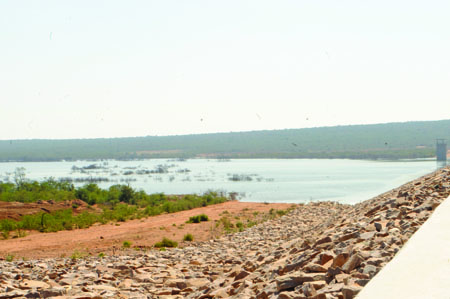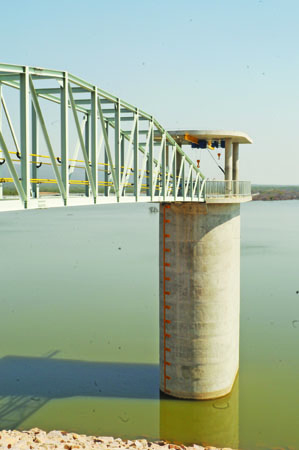Lotsane Dam Yawns
Source : Kutlwano
Author : Ndingililo Gaoswediwe
Location : Palapye
Event : Feature Article
Lotsane Dam Yawns
Article: Ndingililo Gaoswediwe
Photos: Felicity Male
How time flies! But then again, you cannot rewind it so that if flies backwards. Otherwise, Batswapong would fly back to a time when they were so much steeped in tradition and custom.
A time when they would just go to the imposing mountains in their area and plead with their gods for rain. But now they can only wish…wish that if time had a “Push! Push! Push! and rewind” button like a gramophone, the P724 million Lotsane Dam would be overflowing. But this year they looked up the sky and nothing came as the rainy season passed without any significant drops filling the newly built dam.
“Gore tamo e tlale metsi a a bo a tswa Serowe le Moiyabana le dinokana tse di tlang di tswa Kgagodi le bo Mogapinyana,” says Kgosi Phoophoo Mapena of Maunatlala, meaning that for the dam to fill up, its catchment areas will have to register continuous rainfall.
With a disenchanted face, Kgosi Mapena explains that the current water level in the dam is too low to be pumped out hence Maunatlala residents would have to wait a little longer to realize their dream of becoming the first village to taste water from the dam.
Though the dam`s catchment area covers a wide area, Kgosi Mapena is quick to blame the dearth of rain making rituals within the Letswapo area for the dry spell. He explains that in the past, villagers used to gather at Lekgaphong la ga Mmamogatsa Kgari.., beat and dance to a special rhythm of the sound of drums praying for rain.
During or after the ceremony, he says it always rained. However, Kgosi Mapena believes that following Kgosi Masupe Maunatlala`s death in 1949 everything collapsed resulting in rainfall patterns changing as well.
“Fa e le gore tamo ele ba e agile mo tseleng ya Badimo ga e kitla e nna le metsi. Le fa pula e ka na, badimo ba tsile go a ntsha tseleng a bo a elelela gosele,” argues one bus driver as some of his passengers nod in agreement, meaning that if the location of the dam is blocking the path of their ancestors (Badimo) it will never fill up no matter how it rains.
Located at the periphery of Maunatlala village, the 1.4 kilometer and country`s sixth largest dam is now 18 months old but is yet to serve its purpose of quenching the thirst of the 22 Tswapong villages. When Kutlwano team visited the dam in May, the water level was below the 848 mark, the lowest mark on a scale that ranges up to 861. Medium range shrubs were still visible though their roots were submerged in water.
There was no activity around the dam suggesting that all essential construction works such as the 180m wide spillway, irrigation pipeline and pump station had been completed. Nothing disturbed the peace in the dam area except for a team of Kutlwano reporters and two men dressed in bright red tops and black trousers protecting the dam from unwelcome visitors.
As one of them yells at us, our eyes are still stalking the village of Maunatlala as our car moves slowly down the steep drive way gradient. The village appears deserted, save for Ipelegeng workers and a handful villagers who thronged the Kgotla.
“Seemo sa metsi mo kgaolong e se kwa tlase, re nwa metsi a a pompiwang mo didibeng ka digenerator…pula ga e ne sente jaaka kwa Bobirwa kwa matamo a penologang, kwano ke thothinyana hela,” explains Kgosi Mapena.
However, Kgosi Mapena remains optimistic that one day the dam, with a holding capacity of 40 million cubic metres, will fill up. Not only will the dam supply them with water but create employment as well as ease life for villagers who always travel to Sherwood for fresh produce.
Thus, the local communities stand to benefit from a horticultural project covering 250 hectares as well as fishing. Like many residents across Letswapo, another of Maunatlala`s traditional leadership, Kgosi Gobusamang Mapena, is also hopeful that it would not be long before their water problems are solved.
This is because construction of the water reticulation network is in progress since the company is already on site. As months pass, in Maunatlala residents are eager to start their horticultural projects and fishing in the dam. In Seolwane they are longing for rust free water while in Lerala their hope is to see their natural springs flow without any disturbance given that currently they serve as the main source of potable water.
But today, like everywhere else in Botswana, Tswapong residents can only pray and wait for providence to come their way as the dry spell takes its toll. Because of the harsh climate, regular rainfall may occur over a decade, followed by a decade of below average rainfall, often accompanied by severe drought. ENDS














